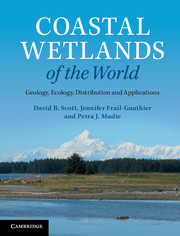Book contents
- Frontmatter
- Contents
- Preface
- List of acronyms and abbreviations
- 1 Introduction: what is covered in this coastal wetlands book?
- 2 Physical aspects: geological, oceanic and climatic conditions
- 3 Zonations and plants: development, stressors and adaptations
- 4 Animals in coastal wetlands: zonation, adaptations and energy flow
- 5 Human intervention causing coastal problems
- 6 Coastal wetlands worldwide: climatic zonation, ecosystems and biogeography
- 7 Examples of North American salt marshes and coastal wetlands
- 8 Examples of South American coastal wetlands
- 9 Africa: selected marsh and mangrove areas
- 10 Europe and Asia: a view of what remains
- 11 Australasia: wetlands of Australia and New Zealand
- 12 Applications in geological monitoring: paleoseismology and paleoclimatology
- 13 Applications in conservation of plant biodiversity and agriculture
- 14 Using mesocosms as a way to study coastal wetlands
- 15 Conclusions and future directions
- References
- Index
- Plate section
7 - Examples of North American salt marshes and coastal wetlands
Published online by Cambridge University Press: 05 July 2014
- Frontmatter
- Contents
- Preface
- List of acronyms and abbreviations
- 1 Introduction: what is covered in this coastal wetlands book?
- 2 Physical aspects: geological, oceanic and climatic conditions
- 3 Zonations and plants: development, stressors and adaptations
- 4 Animals in coastal wetlands: zonation, adaptations and energy flow
- 5 Human intervention causing coastal problems
- 6 Coastal wetlands worldwide: climatic zonation, ecosystems and biogeography
- 7 Examples of North American salt marshes and coastal wetlands
- 8 Examples of South American coastal wetlands
- 9 Africa: selected marsh and mangrove areas
- 10 Europe and Asia: a view of what remains
- 11 Australasia: wetlands of Australia and New Zealand
- 12 Applications in geological monitoring: paleoseismology and paleoclimatology
- 13 Applications in conservation of plant biodiversity and agriculture
- 14 Using mesocosms as a way to study coastal wetlands
- 15 Conclusions and future directions
- References
- Index
- Plate section
Summary
Key points
Arctic wetlands are especially susceptible to damage from climate warming impacts, including permafrost melting, erosion and storm surges; subarctic wetlands are shaped by freeze–thaw cycles and overgrazing by waterfowl; West Coast earthquakes, tsunamis and glacier surges are added stressors in subarctic marshes; temperate marshes of the mountainous West Coast are in isolated valleys, sometimes disconnected from tidal exchange; temperate East Coast marshes are extensive, but altered by farming, frequent hurricanes and ‘nor’easter’ storms; Bay of Fundy megatidal marshes sequester much carbon despite erosion by massive winter ice blocks; subtropical wetlands of Florida and Mexico have shrubby mangroves fringed by brackish water swamp cedars or desert palms and cactus scrub; microtidal Mississippi Delta marshes include floating vegetation islands; tropical mangroves have a high diversity of tall trees and shrubs, particularly in Central America.
Arctic Coast: Mackenzie Delta region of the Beaufort Sea
The Arctic is warming faster than any other region on Earth, bringing dramatic reductions in sea ice extent, altered weather, and thawing permafrost. Implications of these changes include rapid coastal erosion. . . and unpredictable impacts on subsistence activities and critical social needs.
(Clement et al., 2013, in a report to the President.)Arctic salt marshes are literally few and far between (Figure 1.1), occupying scattered segments of the 25 000 km-long Russian coastline (Lantuit et al., 2012; Sergienko, 2013), but covering only about 60 km2 of the Canadian Arctic Islands and small parts of the Arctic shores of Canada and Alaska (Mendelssohn and McKee, 2000; Martini et al., 2009; Jorgenson, 2011). However, there is a growing interest in their ecology and geological history because of their increased contributions to atmospheric greenhouse gases as the permafrost melts (see Section 5.4), and because they occupy deltas and estuaries where gas and oil exploration and shipping terminals are rapidly changing the landscape. Types of possible impacts are outlined in Chapter 5, but here we present selected examples to demonstrate the magnitude of the unfolding events.
- Type
- Chapter
- Information
- Coastal Wetlands of the WorldGeology, Ecology, Distribution and Applications, pp. 72 - 131Publisher: Cambridge University PressPrint publication year: 2014



